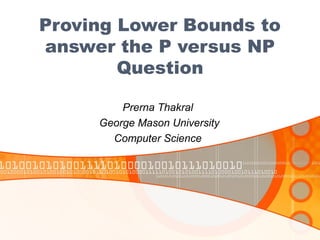
Proving Lower Bounds to Answer the P versus NP Problem
- 1. Proving Lower Bounds to answer the P versus NP Question Prerna Thakral George Mason University Computer Science
- 3. How did we get P versus NP? • Turing developed a model for his computational theory, but it failed to account • time • memory • From this – scientists divided theoretical computer science problems into two classes – P and NP.
- 4. What does the P class hold? • P is for Polynomial Time. • Consists of all those problems whose positive solutions can be solved in an amount of time that is polynomial to the size of the input.
- 5. What does NP class hold? • NP stands for Nondeterministic Polynomial Time. • This class consists of all those problems that can be verified in polynomial time.
- 6. Relationship between P and NP
- 7. Importance and Consequences • A proof of P equals NP could have striking practical consequences. • Will lead to efficient methods for solving some important NP problems, which are fundamental to many fields such as mathematics, biology, etc. • A proof of P does not equal NP will have just as great consequences. • Will show, in a formal way, that many common problems that can be verified easily and efficiently cannot be solved efficiently.
- 8. CURRENT RESEARCH - PROVING LOWER BOUNDS
- 9. Limitations in Problem • A limitation is seen when computer scientists have tried to prove lower bounds on the complexity of problems in the class, NP. • Methods such as diagonalization, the use of pseudo-random generators and circuits are currently being used to prove lower bounds.
- 10. Terminology • Diagonalization is a basic technique used to prove that the set A does not belong to complexity class C. • A combinatorial circuit is a sequence of instructions, each producing a function based on the already obtained previous functions.
- 11. Goal of the Research • Develop a new technique in determining lower bounds by conducting an experiment between the current techniques, diagonalization, and combinatorial circuits and comparing the results to develop a new technique to answer the question whether P equals NP.
- 13. Constants in the Experiment • Lower bounds will be computed on the Travelling Salesman Problem, an NP- complete problem. • The travelling salesman problem will include 15 cities to be toured by finding a path with the shortest distance, visiting each city only once.
- 14. Trials One and Two • Diagonalization technique - a set and function A will be established and used to show that it does not belong to the complexity class EXP, which will conclude that set A is a part of the complexity class NP. • A circuit tree will be created from previously defined functions. Other circuit trees will also be created by limiting the depth of the tree and restricting the original set and function A.
- 15. Trial Three • Set A will use the diagonalization technique and the combinatorial circuits simultaneously to achieve higher efficiency than efficiency that would have reached by using the two techniques individually.
- 17. Efficiency • Efficiency will be measured by the time required to complete the technique and analyze the results to see if the technique produced anything meaningful. • Time required to find a set A, such that it does not belong to the complexity class, EXP will be important. • The time required to create these various circuit trees will also be noted, depending on whether the depth of the tree was limited or if the original function itself was restricted.
- 18. Success • The experiment will be declared as successful if the new technique which uses the two current techniques simultaneously is seen to be more efficient than the other techniques in proving lower bounds.
- 20. Prove P equals/does not equal NP • By knowing how to restrict my classes, P and NP, I will be able to determine that the Travelling Salesman Problem is a part of the P class. • This will allow me to determine which other NP- complete problems can be solved in polynomial time, making them a part of the P class.